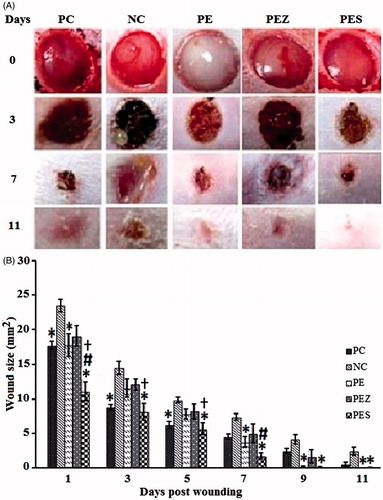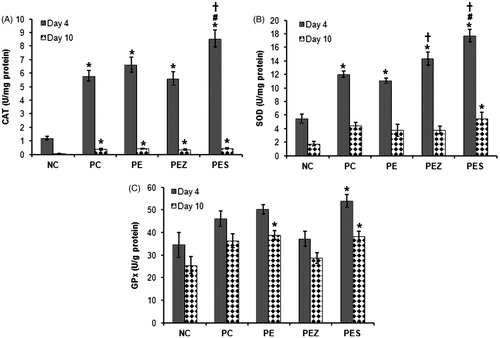Figures & data
Figure 1. (A) Representative photographs of full-thickness excision wounds at different time intervals following treatment with 5 mg/mL papaya PBS extract (PE) with or without trace elements. (B) Wounds were more rapidly healed in PE + 0.5 µg Se2+ (PES) treated group than the positive control (PC), negative control (NC), PE + 100 µM Zn2+ (PEZ). Bars indicate mean ± SEM (n = 10). *, #, and † indicate significantly (p < 0.05) reduced wound size as compared with NC, PC, and PE respectively.

Table 1. Grouping of animals into respective treatment groups.
Table 2. Time for complete wound closure in response to Se2+ and Zn2+ added papaya extract.
Figure 2. Catalase (CAT), superoxide dismutase (SOD), and glutathione peroxidase (GPx) activities in wound tissues following treatment with papaya extract added with Se2+ and Zn2+. NC, negative control; PC, positive control; PE, PBS extract; PES, PE + 0.5 µg Se2+; PEZ, PE + 100 µM Zn2+. Bar indicate mean ± SEM (n = 5); *, #, and † indicate significantly increased (p < 0.05) enzymes’ activities as compared with NC, PC, and PE, respectively.

Figure 3. Malondialdehyde (MDA) levels in wound tissues following treatment with papaya extract added with Se2+ and Zn2+. NC, negative control; PC, positive control; PE, PBS extract; PES, PE + 0.5 µg Se2+; PEZ, PE + 100 mM Zn2+. Bars indicate mean ± SEM (n = 5); * and # indicate significantly (p < 0.05) decreased tissue MDA content as compared with NC and PC, respectively.

Figure 4. Cyclooxygenase-2 (COX-2) and myeloperoxidase (MPO) activities in wound tissues following treatment with papaya extract added with Se2+ and Zn2+. NC, negative control; PC, positive control; PE, PBS extract; PES, PE + 0.5 µg Se2+; PEZ, PE + 100 mM Zn2+. Bars indicate mean ± SEM (n = 5); *, #, and † indicate significantly (p < 0.05) decreased enzymes’ activities as compared with NC, PC, and PE, respectively.

Figure 5. Nitrite () and urea content of wound tissues following treatment with papaya extract added with Se2+ and Zn2+. NC, negative control; PC, positive control; PE, PBS extract; PES, PE + 0.5 µg Se2+; PEZ, PE + 100 mM Zn2+. Bars indicate mean ± SEM (n = 5); *, # and † indicate significantly (p < 0.05) increased nitrite content and decreased urea content as compared with NC, PC, and PE, respectively.

Figure 6. Role of anti-inflammatory and antioxidative bioactive components of papaya PBS extract during wound healing. Bioactive components of papaya PBS extract are involved in regulating the functions of superoxide dismutase (SOD), catalase (CAT), myeloperoxidase (MPO), cyclooxygenase-2 (COX-2), inducible nitric oxide synthase (iNOS), and arginase. Activity of these enzymes eventually contributes to the improved wound healing. PGE2, prostaglandin E2; OAT, ornithine amino transferase; ODC, ornithine decarboxylase; NO, nitric oxide; PMNL, polymorphonuclear leukocytes. [symbols: - -|, inhibition; →, synthesis or activation].
![Figure 6. Role of anti-inflammatory and antioxidative bioactive components of papaya PBS extract during wound healing. Bioactive components of papaya PBS extract are involved in regulating the functions of superoxide dismutase (SOD), catalase (CAT), myeloperoxidase (MPO), cyclooxygenase-2 (COX-2), inducible nitric oxide synthase (iNOS), and arginase. Activity of these enzymes eventually contributes to the improved wound healing. PGE2, prostaglandin E2; OAT, ornithine amino transferase; ODC, ornithine decarboxylase; NO, nitric oxide; PMNL, polymorphonuclear leukocytes. [symbols: - -|, inhibition; →, synthesis or activation].](/cms/asset/2d398549-9225-4a65-a051-161902e0f839/iphb_a_936470_f0006_c.jpg)
